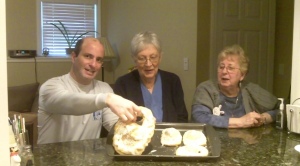I have a number of “staple” recipes in my kitchen, and one of them is my chicken soup. My kids, grandkids and entire family love my chicken soup and I am excited to share the recipe with you. It is great as pre-main meal appetizer or as a meal unto itself. We make it year round– including in the summer! There’s never an end to chicken soup season! I serve my chicken soup at Thanksgiving time and other holidays as an appetizer. Served hot and prinkled with some fresh parmagiano cheese, there’s nothing better!
My recipe is very straightforward. Unlike most other chicken soup recipes, I include mini-meatballs as part of the recipe. I make the base soup, and then mix the broth with the meatballs and pasta. I also serve the chicken and vegetables on the side, which can then be added to the soup mix.
Watch Episode 17 for full details of how to make Mama Lombardo’s Chicken Soup:
To make Mama Lombardo’s Chicken Soup, you will need:
* 1 whole, fresh chicken
* 2 tablespoons of salt
*1 teaspoon of pepper
* 2 tablespoons of fresh tomato sauce
* 1 large onion
* 5-6 carrots
* 1 bunch of celery
* 1/2 pound of ground turkey or beef, prepared for meatballs (see Episode 1 for meatball recipe)
* about 6-7 cups of water (will depend upon the size of the chicken and your pot)
Clean and butcher the chicken
First, you will need to clean and butcher the chicken. Place the chicken in a big pan of water. Sprinkle the chicken with some salt and let soak for 10 minutes. Next, you need to cut the chicken up, cutting the wings, legs and back into pieces. Wash the chicken, then add it back to the pan, covering it with water. Put it on the stove and let the water heat until you see all the excess waste material floating at the top. Turn off the heat, and then pour out all the water, straining the chicken. Rinse the chicken and then place back into a large pan and put on the stove.
Prepare the vegetables
Peel skin off the onion, leaving it whole. Put it aside in a bowl with some water. Next, take the skin off the carrots and cut off the ends. Place aside with the onion. Next, cut the very end of the leaves off the celery. Then cut the celery in half, taking the half with the leaves and placing it in the bowl with the onions and carrots. Place 3 of the cut celery stalks in the bowl as well. Finally, cut 3 of the carrots up with a knife, width-wise. Cut 3 of the carrots in half. Place the carrot halves in the bowl with the onion and celery. Take the carrot “wheels” and place them in a separate bowl (you’ll be cooking these with the meatballs).
Prepare the meatballs
You can use either ground turkey or beef for the meatballs. Once you’ve prepared the meat for meatballs (see Episode 1 for how to prepare the meatballs), start rolling them with your hands into small meatballs (about the size of a marble). Place them in a dish as you roll them out. Boil some water, and add the meatballs to the water. Also add the carrot wheels. Let the mixture boil for about 10 minutes.
Make the soup
Now that you’re done preparing all the ingredients, it’s time to make the soup! Turn the heat on high on the pan with the water and chicken it it (make sure you have enough water that the chicken is covered). Add the whole carrots, onions and celery to the water with the chicken. Add a tablespoon of salt and pepper. Finally, add the tablespoons of tomato sauce. The sauce will give the soup a rich color. Bring the soup to a boil. After 2-3 minutes of boiling, lower it to a simmer. You will need to let the soup simmer for about 60-90 minutes. You’ll know it’s done when the chicken and vegetables are fully cooked.
Cooking the pasta
The final step is cooking pasta, which you’ll serve with the soup. I prefer to use small sized pasta, preferably ancini di pepe. Cook the pasta al dente, then strain.
Serving the soup
When the soup is done, add some soup to meatballs and carrots. Then add soup the pasta. Finally, add meatballs and carrots to the pasta. Serve the chicken and vegetables on the side. Encourage your guests to mix the chicken and vegetables in with the soup! Finally, sprinkle the soup and pasta with some freshly grated parmigiano or pecorino romano cheese. Add pepper if desired. Serve hot and enjoy!
The soup is authentic, simple and tasty. It’s great fresh or saved for later. In fact, I often freeze my soupe and pull it out to serve at a later date.
We hope you enjoy Mama Lombardo’s Chicken Soup and will give it a try. Let us know your thoughts!

















